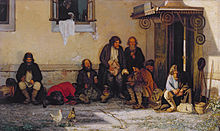Zemstvo

Zemstvo ( Russian Земство; wiss. Transliteration Zemstvo ) means land estate or landscape representation and denotes local self-government units at the district and governorate level in the Russian Empire , which were introduced in 1864 as part of liberal reforms under Tsar Alexander II .
Representatives of the nobility , townspeople and peasants were elected for three years in the respective Zemstvo . The tasks of the local administrations included, among other things, health, education, postal and transport, welfare and poor relief , industry, trade and agriculture. The financing was based on tax revenues, for which the respective Zemstvo administrations were also responsible.
During the First World War , the Semstwob movement under Prince Georgi Lwow, which was combined in a national organization in the All-Russian Semstwobund in 1914, achieved a decisive role in Russia's war economy. In 1916 the federal government had around 8,000 affiliated individual institutions with several hundred thousand employees and a budget of two billion rubles . The Zemstvo organizations tried to close the gap which the military planning in the prewar period in the supply of soldiers and civilians as well as the supply organization of the army with the means organized by them. In addition to donations, she also relied on numerous volunteers who worked free of charge in the institutions of Zemstvo. A minister in the Tsarist government described the Zemstvo organizations as a parallel government of Russia during the war.
A decree of the Council of People's Commissars of December 23, 1917/5. January 1918 disempowered the leadership of the Zemstvo and the city councils (Stadtbünde). Just a few days later, the committees of the leadership of the city federations were approved by a further decree of 4/17. Banned January 1918. The ownership shares had to be transferred to the Supreme Economic Council. Since 18./31. December 1917 had a people's commissariat for the local Zemstvo supervision. In the course of the revolutionary upheavals, the Zemstwos were dissolved in early 1918. Their function should be taken over by the Soviets .
The statistical organs created after the reform of 1861 at the Zemstvo administrations carried out statistical surveys and published numerous overviews and statistical collections for the individual administrative areas, the value of which was due to the often tendentious processing and problematic grouping of the material on the part of the Zemstvo statisticians, who were mainly Narodniki , was reduced considerably. However, Lenin used these statistics extensively in his early writings.
See also
Individual evidence
- ↑ Orlando Figes: Russia - The Tragedy of a People - The Epoch of the Russian Revolution 1891 to 1924 , Berlin, 2014, pp. 294–296
swell
- Erich Bayer (Hrsg.): Dictionary of history. Terms and technical terms (= Kröner's pocket edition . Volume 289). 3rd, revised edition. Kröner, Stuttgart 1974, ISBN 3-520-28903-2 , p. 471.
- Brockhaus Enzyklopädie (24 volumes): Volume 20. Mannheim 1993, p. 122.
- Postage stamps and postal history of Russia
- Haberkern, Eugen / Wallach, Joseph Friedrich: auxiliary dictionary for historians. Middle Ages and Modern Times. Bern / Munich 1964, p. 567.
- GN Golikow, MI Kuznetsov: Enciklopedija Velikaja Oktjabrskaja socialisticeskaja revoljucija . Soviet Encyclopedia Publishing House , Moscow 1977